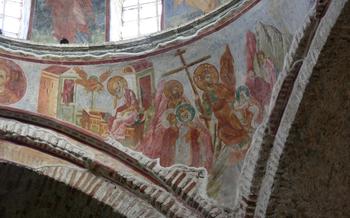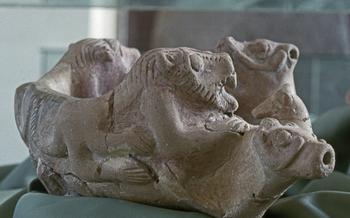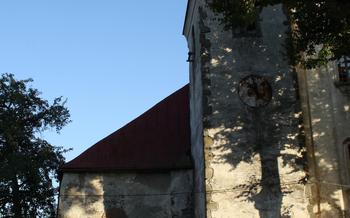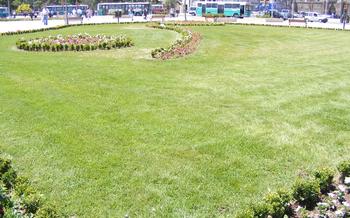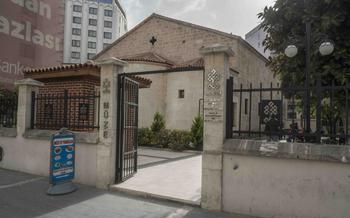
Mahzemin Church
- Mahzemin Church: A Hidden Gem in Kayseri
- Location and Accessibility
- Hours of Operation and Admission
- Historical Background
- Architectural Features
- Byzantine Frescoes and Mosaics
- Religious Significance
- Cultural Importance
- UNESCO World Heritage Site
- Photography Tips
- Guided Tours
- Combining with Other Kayseri Attractions
- Tips for Visitors
- Insider Tip: Hidden Passage
Mahzemin Church: A Hidden Gem in Kayseri
In the heart of Kayseri, Turkey, lies a hidden gem that transports visitors back in time to the Byzantine era. The Mahzemin Church, also known as St. Basil's Church, is an architectural treasure that has stood the test of time, showcasing the rich history and cultural heritage of the region. Built in the 11th century, during the reign of the Byzantine Emperor Basil II, this church holds immense historical significance as a testament to the grandeur and artistic achievements of the Byzantine civilization.
The Mahzemin Church is a true architectural marvel, boasting intricate stonework, towering domes, and beautifully preserved Byzantine frescoes. Its impressive facade features arched doorways, decorative motifs, and a blend of Romanesque and Byzantine architectural styles. Step inside, and you'll be greeted by a breathtaking interior adorned with vibrant frescoes depicting scenes from the Bible, offering a glimpse into the religious beliefs and practices of the Byzantine era.
Location and Accessibility
The Mahzemin Church is nestled in the heart of Kayseri's historic district, a treasure trove of architectural wonders and cultural heritage. To reach this hidden gem, visitors can embark on a leisurely stroll through the city's vibrant streets, lined with traditional Ottoman-era houses and bustling shops. The church is conveniently located within walking distance of many of Kayseri's other notable landmarks, such as the Kayseri Castle and the Grand Mosque.
For those who prefer the convenience of public transportation, Kayseri boasts a reliable network of buses and dolmuşes that can whisk you to the church's doorstep. Simply hop on a bus or dolmuş heading towards the city center and ask the driver to drop you off at the Mahzemin Church. Once you arrive, you'll find yourself immersed in the charm of this ancient neighborhood, where history and spirituality intertwine.
Parking is readily available in the vicinity of the church, making it easy for visitors to arrive by car. Several public parking lots are located within a short walking distance, providing a convenient and secure option for those who choose to drive. Whether you prefer to explore the city on foot, by public transportation, or by car, reaching the Mahzemin Church is a breeze.
Hours of Operation and Admission
The Mahzemin Church welcomes visitors during specific hours to ensure proper preservation and management. Plan your visit accordingly to avoid disappointment.
- Visiting Hours:
- Summer (April-October): Daily from 8:00 AM to 6:00 PM
-
Winter (November-March): Daily from 9:00 AM to 5:00 PM
-
Ticket Prices:
- Adults: 30 Turkish Lira
- Children (under 18): 15 Turkish Lira
-
Students and seniors (with valid ID): 20 Turkish Lira
-
Discounts and Concessions:
- Group discounts are available for bookings of 10 or more people.
-
Discounted rates apply for educational and cultural organizations with prior arrangements.
-
Guided Tours:
- Guided tours in various languages are available upon request and subject to availability.
- Pre-booking is recommended to secure your preferred time and language.
- Guided tours offer in-depth insights into the church's history, architecture, and religious significance.
Historical Background
The origins of the Mahzemin Church can be traced back to the 10th century, during the Byzantine era. Built as a rock-cut church, it served as a place of worship and spiritual gathering for the Christian community in Kayseri. The church's construction reflects the influence of Byzantine architecture and artistic traditions that were prevalent in the region during that time.
The church's primary purpose was to facilitate religious ceremonies and rituals, including prayer services, baptisms, and other sacraments. It also served as a center for religious instruction and education, where the faithful could deepen their understanding of the Christian faith and its teachings.
The Mahzemin Church held religious significance as a sacred space where believers could connect with the divine and seek spiritual guidance. Over the centuries, it became an important pilgrimage site for Christians from neighboring regions, who would visit to pay homage and offer prayers.
Throughout history, the church has witnessed numerous events that have shaped its significance. It has endured wars, conquests, and changes in political power, serving as a resilient symbol of faith and continuity amidst the shifting tides of time.
Architectural Features
The Mahzemin Church stands as a testament to the architectural prowess of its Byzantine builders. Its exterior design exudes an air of simplicity, with unadorned walls and a single entrance. Upon entering, visitors are greeted by a harmonious interior layout that is both spacious and intimate. The church's single nave is supported by a series of graceful arches, creating a sense of height and grandeur.
Notable elements within the church include the intricate carvings adorning the capitals of the columns, each depicting unique motifs and symbols. Hidden details, such as small niches and hidden chambers, reveal the ingenuity of the architects and the care taken in the church's construction. The church's overall design reflects a deep understanding of acoustics, ensuring that the spoken word and prayers resonate throughout the space.
Byzantine Frescoes and Mosaics
The Mahzemin Church is adorned with exquisite Byzantine frescoes and mosaics that transport visitors back in time. Skilled artisans meticulously crafted these artworks, using vibrant pigments and intricate brushstrokes to depict scenes from the Bible and the lives of saints. The frescoes cover the walls and ceilings, creating a rich visual tapestry that captivates the eye. Many of the frescoes retain their original brilliance, despite the passage of time, showcasing the exceptional artistry of the Byzantine masters.
The iconography and symbolism embedded in the frescoes are profound, offering insights into the religious beliefs and practices of the Byzantine era. Each fresco tells a story, conveying messages of faith, hope, and redemption. The subjects range from depictions of Christ and the Virgin Mary to scenes of martyrdom and resurrection. The church has also become a beacon for pilgrimage, attracting visitors from all over the world.
The church authorities have undertaken meticulous conservation efforts to preserve these precious artworks for future generations. Visitors are urged to respect the fragile nature of the frescoes and avoid touching or leaning against them. By adhering to these guidelines, we can ensure that this artistic heritage remains intact for years to come.
To fully appreciate the beauty and detail of the frescoes, visitors are encouraged to take their time andじっくりと explore the church. The church's interior is well-lit, allowing visitors to admire the frescoes from various angles. Taking photographs is permitted, but using a flash is prohibited, as it can damage the delicate pigments.
Religious Significance
The Mahzemin Church holds immense religious significance as a sacred site for Christians, particularly those belonging to the Orthodox tradition. Throughout history, it has served as a place of worship and pilgrimage, attracting devout believers from near and far. The church is believed to possess several holy relics, including fragments of the True Cross and bones of revered saints. These relics have imbued the church with a profound sense of sanctity and have drawn pilgrims seeking spiritual enlightenment and blessings. The sacred atmosphere that permeates the church's interior creates a powerful connection between visitors and their faith, making it a cherished destination for those seeking a deeper spiritual experience.
Cultural Importance
The Mahzemin Church stands as a testament to the cultural heritage of Kayseri. It represents a unique fusion of Byzantine and local influences, showcasing the rich history of the region. The church's well-preserved frescoes and mosaics provide a glimpse into the vibrant artistic traditions of the Byzantine era. Moreover, it serves as a symbol of religious coexistence, having been used by different Christian denominations throughout the centuries. Its historical and cultural significance make it an invaluable asset to Kayseri's cultural heritage.
Beyond its religious significance, the Mahzemin Church also holds educational value. It offers a unique opportunity to learn about Byzantine art and architecture, shedding light on the cultural and artistic achievements of the period. The church's well-preserved condition allows visitors to gain a deeper understanding of the techniques and styles employed by Byzantine craftsmen. Moreover, the church's historical significance and connection to different religious communities provide a valuable lesson in religious tolerance and coexistence.
UNESCO World Heritage Site
The Mahzemin Church's cultural and historical significance is further recognized by its designation as a UNESCO World Heritage Site. This prestigious status reflects the church's outstanding universal value, meeting specific criteria set by UNESCO.
The Mahzemin Church's inclusion on the World Heritage list is a testament to its exceptional architectural and artistic features, its role as a unique example of Byzantine art, and its historical importance as a pilgrimage site. UNESCO's recognition highlights the church's global significance and the need for its preservation and protection.
As a World Heritage Site, the Mahzemin Church benefits from increased international recognition and cooperation for conservation efforts. The designation also raises awareness of the church's significance, attracting more visitors and promoting cultural tourism in Kayseri.
Being a UNESCO World Heritage Site not only enhances the church's reputation but also places it among other remarkable cultural landmarks worldwide, contributing to the preservation and appreciation of our shared cultural heritage.
Photography Tips
To capture the essence of Mahzemin Church in your photographs, consider visiting during the golden hours of sunrise or sunset. The warm light casts a mesmerizing glow on the church, enhancing its architectural features and creating a magical atmosphere.
For optimal camera settings, use a wide-angle lens to capture the grandeur of the interior. Adjust your ISO to maintain image quality while minimizing noise, and choose a low aperture to achieve a sharp focus and shallow depth of field.
When photographing the Byzantine frescoes, position yourself directly in front to avoid distortions. Use a tripod and a remote shutter release to ensure stability and prevent camera shake. Experiment with different angles and perspectives to capture the intricate details and vibrant colors of these stunning artworks.
Don't miss the photo opportunities presented by the church's unique features, such as the hidden passageway and the stunning views from the rooftop. These vantage points offer unique perspectives and allow you to capture the church's beauty from various angles.
Guided Tours
Enhance your visit to the Mahzemin Church by joining a guided tour, available in various languages for the convenience of international visitors. With a knowledgeable guide leading the way, you'll gain in-depth historical insights into the church's origins, significance, and architectural features.
Guided tours offer a deeper understanding of the church's religious importance, as well as intriguing anecdotes and stories that bring history to life. Listen to tales of pilgrims and saints, learn about the symbolism behind the frescoes and mosaics, and uncover the secrets of the church's hidden passageway.
Taking a guided tour allows you to ask questions and receive personalized explanations, ensuring you leave with a comprehensive understanding and appreciation for this remarkable site. Whether you're a history buff, an art enthusiast, or simply curious about different cultures, a guided tour of the Mahzemin Church is a worthwhile investment.
Combining with Other Kayseri Attractions
The Mahzemin Church is not the only historical and cultural attraction in Kayseri. Visitors can easily combine their visit to the church with other nearby sites to create a comprehensive itinerary. Just a short walk away, the Hunat Hatun Mosque stands as a testament to Seljuk architecture, with its intricate tilework and graceful minaret. The Kayseri Castle, located on a hilltop, offers panoramic views of the city and houses several museums showcasing the region's rich history and culture.
For those interested in art and archaeology, the Kayseri Archaeological Museum is a must-visit. It houses a vast collection of artifacts from various periods, including the Hittite, Roman, and Byzantine eras. The museum provides a deeper understanding of the region's ancient past and its significance in the development of Anatolian civilization.
To create a well-rounded day trip, visitors can explore the vibrant Kayseri Bazaar, a bustling marketplace where one can find a variety of local handicrafts, souvenirs, and traditional Turkish cuisine. The bazaar offers a glimpse into the daily life of the city's inhabitants and provides an opportunity to interact with friendly locals.
By combining the Mahzemin Church with these other attractions, visitors can create a comprehensive and enriching itinerary that showcases the diverse cultural and historical heritage of Kayseri.
Tips for Visitors
Dress code and etiquette: When visiting the Mahzemin Church, it is important to dress respectfully, covering your shoulders and knees. Be mindful of the religious significance of the site and avoid loud or disruptive behavior.
Respecting the religious significance: The church is still an active place of worship, so it is important to be respectful of the religious practices and ceremonies that may be taking place. Visitors should avoid talking or taking photos during services.
Avoiding crowds: To avoid the crowds, it is best to visit the church early in the morning or late in the afternoon. Weekends and holidays are typically busier, so if possible, try to visit on a weekday.
Recommended time to visit: The best time to visit the Mahzemin Church is during the spring or fall when the weather is mild. During the summer, the heat can be intense, and in the winter, the church may be closed due to snow and ice.
Insider Tip: Hidden Passage
Beyond the awe-inspiring frescoes and historical significance, Mahzemin Church holds a secret passageway that few visitors know about. This hidden tunnel, uncovered during restoration work, offers a unique and intriguing experience for those who venture to explore it.
The passageway, which was likely used by monks or priests for secret communication or escape during times of danger, is accessible through a discreet doorway in the church's interior. As you step through the door, you'll find yourself in a narrow, dimly lit tunnel that winds its way through the depths of the church.
Walking through the passage, you'll feel a sense of mystery and wonder as you imagine the people who may have traversed this hidden path centuries ago. The walls are cool and damp, and the air is still and silent, creating an atmosphere that is both eerie and captivating.
The tunnel eventually leads to a small, hidden chamber, which is believed to have been used as a hiding place or a secret meeting room. Here, you can take a moment to reflect on the rich history of the church and the lives of those who sought refuge within its walls.
Discovering the hidden passageway at Mahzemin Church is like uncovering a secret chapter in the history of this remarkable place. It's an experience that will stay with you long after your visit and will add an extra layer of fascination to your exploration of this ancient gem.
